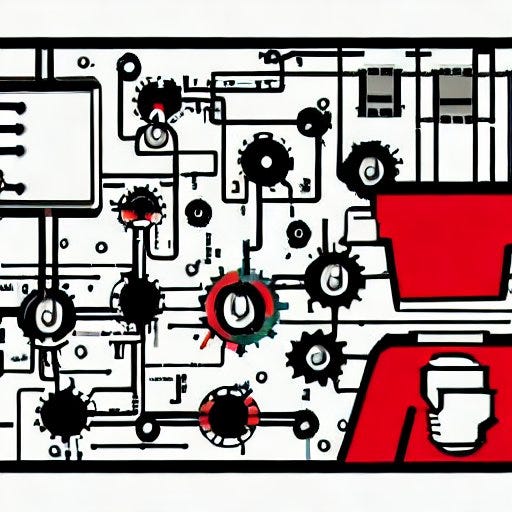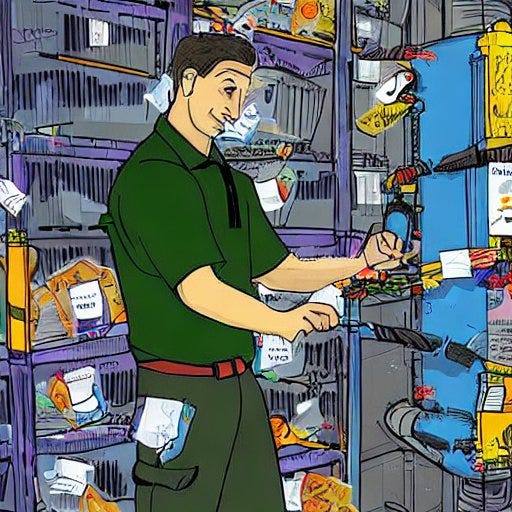Understanding Memory Management - The Key to Efficient Programming in Any Language
BackPublished on April 01, 2023
Memory management is a critical aspect of programming languages that involves allocating and deallocating memory during program execution. Here are some key concepts related to memory management:
- Memory allocation: When a program needs to store data, it requests memory from the operating system. The memory can be allocated statically, at compile time, or dynamically, at runtime.
- Memory deallocation: Once the program is finished using the memory, it must be returned to the operating system. Failure to do so can lead to memory leaks, which can cause the program to crash or slow down over time.
- Garbage collection: In some programming languages, such as Java and Python, memory management is automated through a process called garbage collection. This involves periodically scanning the program’s memory to identify and free up memory that is no longer in use.
- Pointers: In low-level programming languages such as C and C++, memory is managed using pointers. These are variables that store memory addresses, allowing the program to manipulate memory directly. However, incorrect use of pointers can lead to memory leaks and other errors.
- Memory safety: Memory safety refers to the prevention of memory-related errors such as buffer overflows, null pointer dereferences, and use-after-free errors. Programming languages that prioritize memory safety, such as Rust and Swift, use techniques such as ownership and borrow checking to ensure that memory is used correctly.

What is the main idea behind garbage collection? How does it work?

The main idea behind garbage collection is to automate the process of memory management in programming languages by automatically detecting and freeing memory that is no longer in use. This eliminates the need for programmers to manually allocate and deallocate memory, which can be error-prone and time-consuming.
Garbage collection works by periodically scanning the program’s memory to identify memory that is no longer in use. This is typically done by tracing through the program’s data structures to find all the objects that are still reachable from active variables or from the stack. Any memory that is not reachable, or that is only reachable through other unreachable memory, is considered garbage and can be freed.
The garbage collection algorithm typically uses a combination of reference counting and tracing to determine which memory is still in use. Reference counting involves keeping track of the number of references to each object, and freeing the object when the reference count drops to zero. Tracing involves starting from a set of “roots” (typically active variables and the stack) and following all the pointers to other objects in memory. Any object that is not reached during the tracing process is considered garbage.
There are various algorithms that can be used for garbage collection, such as mark-and-sweep, generational, and concurrent garbage collection. Each algorithm has its own trade-offs in terms of performance, memory usage, and responsiveness, and the choice of algorithm depends on the specific requirements of the programming language and the application being developed.
What is the main idea behind pointers? How does it work?
 Do you know what to do with pointers? 😉
Do you know what to do with pointers? 😉
The main idea behind pointers in programming is to allow direct manipulation and referencing of memory locations in a program. A pointer is a variable that stores the memory address of another variable, allowing the programmer to access and modify the contents of that memory location.
When a pointer variable is declared, it is typically initialized with the memory address of another variable using the “address-of” operator (&). For example, the following code declares a pointer variable p and initializes it with the address of the integer variable x:
int x = 42;
int *p = &x;
The * in the declaration of p indicates that p is a pointer to an integer.
Once a pointer variable is initialized, it can be used to access and modify the value of the variable it points to using the “dereference” operator (*). For example, the following code modifies the value of x indirectly by dereferencing p and assigning a new value:
*p = 123;
After executing this code, the value of x will be changed to 123.
Pointers are particularly useful in low-level programming languages such as C and C++ for tasks such as memory management, data structures, and system-level programming. However, they can be error-prone if used incorrectly, as they allow the programmer to manipulate memory directly, which can lead to memory leaks, buffer overflows, and other types of memory-related errors.
What is the main idea behind memory safety? How does it work?

The main idea behind memory safety in programming is to prevent errors related to memory management, such as buffer overflows, null pointer dereferences, use-after-free errors, and other security vulnerabilities. Memory safety ensures that programs do not access memory in a way that is unintended or unsafe, which can cause crashes or allow attackers to exploit vulnerabilities.
Memory safety works by enforcing strict rules on how memory is accessed and managed by a program. These rules are typically enforced by the programming language or the runtime environment, and can include the following:
- Bounds checking: Memory safety mechanisms can check that array and buffer accesses are within their allocated bounds, preventing buffer overflows and other memory-related errors.
- Null pointer checks: Memory safety mechanisms can prevent null pointer dereferences by checking that pointers are not null before they are dereferenced.
- Ownership and borrowing: Memory safety mechanisms such as those in the Rust programming language can enforce ownership and borrowing rules to ensure that memory is only accessed in a safe and controlled manner.
- Garbage collection: Garbage collection, as mentioned earlier, is a memory safety mechanism that automatically manages memory by freeing objects that are no longer in use.
- Memory-safe programming languages: Certain programming languages such as Rust, Swift, and Java are designed with memory safety in mind and enforce strict rules on how memory is managed and accessed by a program.
By enforcing these and other memory safety mechanisms, programming languages and runtime environments can help ensure that programs are safe and secure, and prevent a wide range of memory-related errors and vulnerabilities.
What programming languages use generational garbage collection techniques for managing memory?
Generational garbage collection is a technique used in many programming languages for managing memory. Some of the programming languages that use generational garbage collection include:
- Java: Java’s garbage collector uses a generational algorithm to manage memory. The heap is divided into young and old generations, and objects are initially allocated in the young generation. The garbage collector uses a mark-and-sweep algorithm to identify and free unused objects in the young generation, and periodically moves surviving objects to the old generation.
- Python: Python’s garbage collector uses a variant of the generational algorithm called “incremental garbage collection”. The heap is divided into three generations, and objects are initially allocated in the youngest generation. The garbage collector uses a combination of reference counting and tracing to identify and free unused objects in the young generation, and periodically moves surviving objects to older generations.
- Ruby: Ruby’s garbage collector uses a generational algorithm with two generations. Objects are initially allocated in the young generation, and the garbage collector uses a mark-and-sweep algorithm to identify and free unused objects in the young generation. Surviving objects are moved to the old generation, which is managed using a separate garbage collector.
- Go: Go’s garbage collector uses a tri-color mark-and-sweep algorithm with two generations. Objects are initially allocated in the young generation, and the garbage collector uses a mark-and-sweep algorithm to identify and free unused objects in the young generation. Surviving objects are moved to the old generation, which is managed using a separate garbage collector.
- JavaScript: Many JavaScript engines, including V8 and SpiderMonkey, use a generational garbage collector with two or three generations. Objects are initially allocated in the youngest generation, and the garbage collector uses a mark-and-sweep algorithm to identify and free unused objects in the young generation. Surviving objects are moved to older generations, which are managed using separate garbage collectors.
These are just a few examples of programming languages that use generational garbage collection to manage memory. Many other programming languages also use this technique, or variations thereof, as it is a popular and effective way to manage memory in modern programming languages.
Is the garbage collection process blocking operation?

Whether or not the garbage collection process is a blocking operation depends on the implementation of the garbage collector and the programming language or runtime environment in use.
In some cases, garbage collection can be a blocking operation, meaning that the program must pause execution while the garbage collector runs. During this time, the program cannot perform any other operations, which can result in decreased performance or even temporary freezing of the program. This is often the case with “stop-the-world” garbage collectors, which pause the program during garbage collection.
However, not all garbage collectors are blocking. Some garbage collectors use concurrent or incremental algorithms, which allow the program to continue executing while garbage collection is performed in the background. These algorithms are designed to minimize or eliminate the pauses that occur during garbage collection, which can improve program performance and user experience.
Some programming languages, such as Java and .NET, use a combination of different garbage collection algorithms, including both blocking and non-blocking algorithms. These languages also provide options for configuring garbage collection behaviour, which can allow developers to tune the performance of the garbage collector to meet their specific needs.
In summary, whether or not garbage collection is a blocking operation depends on the implementation of the garbage collector and the programming language or runtime environment in use. While some garbage collectors may be blocking, others use non-blocking or concurrent algorithms that allow the program to continue executing while garbage collection is performed in the background.
What is an incremental garbage collector?

An incremental garbage collector is a type of garbage collector that allows a program to continue executing while garbage collection is performed in the background. This is in contrast to “stop-the-world” garbage collectors, which pause the program during garbage collection.
In an incremental garbage collector, the garbage collector breaks the garbage collection process into small, incremental steps that are interleaved with the program’s normal execution. For example, the garbage collector might perform one step of garbage collection for every 10 or 100 operations executed by the program. By breaking the garbage collection process into smaller steps, the garbage collector can minimize the impact on program performance and reduce the likelihood of noticeable pauses or freezes.
Incremental garbage collectors are typically used in environments where responsive performance is critical, such as interactive applications or real-time systems. By allowing the program to continue executing during garbage collection, these systems can maintain a more consistent level of responsiveness and avoid long pauses that could negatively impact user experience.
One disadvantage of incremental garbage collection is that it can increase the overhead of garbage collection, as the garbage collector must maintain more state and perform more bookkeeping to track the progress of garbage collection. This can result in slightly slower garbage collection performance compared to stop-the-world garbage collectors. However, the benefits of maintaining program responsiveness often outweigh this overhead.
Many programming languages and runtime environments support incremental garbage collection, including Java, .NET, and some JavaScript engines.
Trilemma: throughput, pauses, resources (CPU/Memory)?

The garbage collection trilemma refers to the challenge of balancing three competing goals in garbage collection: throughput, pauses, and resource utilization (CPU and memory usage).
- Throughput refers to the rate at which the garbage collector can identify and free unused memory. To maximize throughput, the garbage collector should be able to quickly identify unused memory and efficiently free it.
- Pauses refer to the amount of time that the program is paused while garbage collection is performed. To minimize pauses, the garbage collector should be able to identify and free unused memory quickly and efficiently without causing significant delays to the program execution.
- Resource utilization refers to the amount of CPU and memory resources used by the garbage collector. To minimize resource utilization, the garbage collector should be designed to use resources efficiently and effectively, without consuming too much CPU or memory resources that could be used by the program.
Managing this trilemma requires a careful balance of these competing goals. Different programming languages and runtime environments may use different garbage collection strategies to manage the trilemma, depending on the specific needs of the application and the available system resources. Some programming languages and environments allow adjusting a garbage collector’s behaviour.
Tuning garbage collection to balance throughput, pauses, and resource utilization depends on the specific garbage collection algorithm being used and the requirements of the application being developed. Here are some general strategies that can be used to tune garbage collection:
- Throughput: To maximize throughput, a generational garbage collection algorithm can be used. This algorithm focuses on the youngest generation of objects, which are typically short-lived and can be freed quickly. Additionally, the garbage collector can be tuned to allocate more memory to the young generation, which can reduce the frequency of garbage collection cycles and improve throughput. Other strategies for improving throughput include parallelizing garbage collection across multiple processors and using an incremental or concurrent garbage collector that runs in the background while the program is executing.
- Pauses: To minimize pauses, a concurrent or incremental garbage collector can be used. This garbage collection algorithm allows the program to continue executing while garbage collection is performed in the background, minimizing the impact on program performance. Additionally, a “pauseless” garbage collector can be used that is able to free memory without stopping the program’s execution. Other strategies for reducing pauses include optimizing the garbage collector to reduce the frequency and duration of garbage collection cycles and using a garbage collector that is able to dynamically adjust its behaviour based on the available system resources.
- Resource Utilization: To minimize resource utilization, a “greedy” garbage collector can be used that aggressively frees memory and minimizes the amount of memory used by the program. Additionally, the garbage collector can be optimized to reduce the amount of CPU and memory resources required to perform garbage collection, such as by using efficient data structures and algorithms. Other strategies for reducing resource utilization include using a garbage collector that is able to dynamically adjust its behaviour based on the available system resources and tuning the garbage collector to allocate memory more efficiently.
Overall, tuning garbage collection requires a careful balance of throughput, pauses, and resource utilization. Different programming languages and runtime environments may use different strategies to manage the trilemma, depending on the specific needs of the application and the available system resources.
What can an application achieve by tuning the garbage collector?

Tuning the garbage collector can help applications achieve several benefits, such as:
- Improved Performance: Tuning the garbage collector can lead to improved application performance by reducing the amount of time spent on garbage collection and minimizing the impact of garbage collection on application response time.
- Reduced Memory Footprint: Garbage collection tuning can help reduce the amount of memory consumed by the application, leading to reduced memory usage and improved scalability. This can be especially important in cloud environments where memory usage can have a direct impact on application cost.
- Reduced Latency: Tuning the garbage collector can help reduce the amount of time spent on garbage collection pauses, leading to lower application latency and improved user experience.
Some cloud service-related examples of tuning the garbage collector include:
- AWS Lambda: AWS Lambda allows users to configure the amount of memory allocated to each function instance. Tuning the garbage collector can help reduce memory usage and improve the performance of Lambda functions, which can lead to reduced costs and improved application scalability.
- Azure Functions: Azure Functions also allows users to configure the amount of memory allocated to each function instance. Garbage collection tuning can help reduce the impact of garbage collection on function response time and improve application performance.
- Google Cloud Functions: Google Cloud Functions automatically scales the amount of memory allocated to each function instance based on the workload. Tuning the garbage collector can help ensure that garbage collection does not consume too much CPU or memory resources, leading to improved performance and lower costs.
Overall, tuning the garbage collector can help improve application performance, reduce memory footprint, and improve user experience in cloud environments.
In summary, having knowledge of data structures and memory management is essential for writing efficient and performant code in any programming language. By understanding how memory works in a particular language, developers can make informed decisions about how to allocate and manage memory resources for their applications.
Knowing the specifics of a language’s memory management can also help developers optimize their code for performance and avoid common memory-related issues, such as memory leaks, dangling pointers, and buffer overflows.
Moreover, understanding memory management is particularly important in the context of modern computing, where applications are often designed to run in cloud environments with limited resources. In these environments, optimizing memory usage can help reduce costs and improve application scalability.
Overall, having memory awareness and an understanding of how data structures work and how memory is managed in a particular language is critical for building efficient, scalable, and robust applications. It can help developers avoid memory-related issues, optimize performance, and improve user experience in a variety of computing environments.
Originally posted on Understanding Memory Management: The Key to Efficient Programming in Any Language